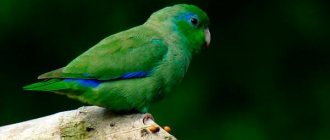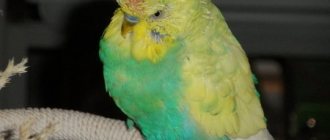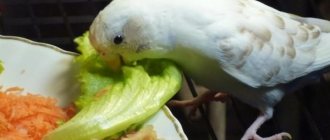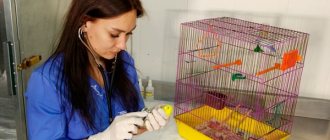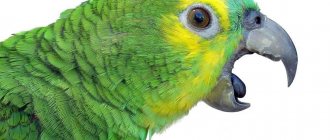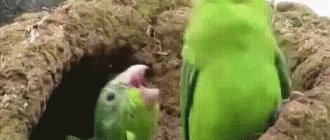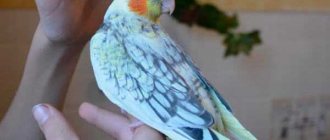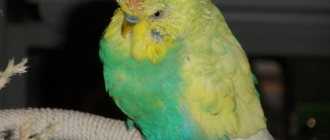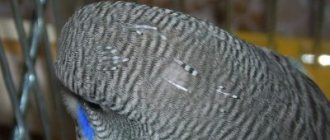- home
- Parrot
- FAQ
04/22/2019 The parrot loves to fly, but sometimes it happens that the pet suddenly stops flying. The reasons why a parrot does not fly can be very different - from illness and injury to poor nutrition and stress. It is very important to identify the problem as early as possible and help the feathered pet return to a normal, full life. Regardless of what species the bird belongs to - miniature budgies or large cockatoos, it needs movement and physical activity. The inability to fly shortens the bird's lifespan. Therefore, belated assistance may be ineffective.
Treatment
Every owner should be able to provide first aid to a feathered pet. If you have a cold, it is enough to warm the parrot (turn on an infrared lamp near the cage) and drink it with chamomile infusion.
Poisoning is of particular concern: small parrots have a very fast metabolism. Toxins that enter the body instantly penetrate all systems. A ruffled parrot with its eyes closed involuntarily shows that it needs urgent treatment. Sometimes the hours count.
The benefits and dangers of flying
As you probably already understood, the fact that your parrot cannot fly from branch to branch or indoors indicates that it has some kind of deviation.
The danger of such a lifestyle is that birds can develop diseases such as obesity, osteoporosis, depression, muscle atrophy, etc. If the parrot leads an active lifestyle, then there will be no reason to worry about its physical shape.
At the same time, many novice bird breeders make the same mistake. They themselves often hinder and limit the freedom of birds. A common reason for this is often the desire to protect their charges from other pets like cats or to prevent them from flying away in cases where the windows in the room are constantly open.
Effect of feed on bird activity
It's no secret that birds that receive all the vitamins and minerals necessary for their body along with food lead an active lifestyle. If this is not so, then the picture is completely opposite.
A poorly nourished pet will likely be lethargic and inactive. In this case, he spends the whole day half asleep. Moreover, if this situation has been going on for a long time, the parrot will weaken and may even die.
In cases where you notice a change in its condition in time and balance the food, within two months the bird will return to its usual rhythm of life and begin to fly more often.
However, on the other hand, excessive care can result in your ward becoming obese and again becoming inactive. In such cases, you are unlikely to be able to get the parrot to fly.
Amyotrophy
Often the reason that a parrot does not fly can be muscle atrophy. It occurs when the bird is rarely allowed to fly and spends almost all its time in its cage. Limiting physical activity causes muscles to forget their functions. The parrot does not fly, but walks.
To avoid atrophy, you should purchase a cage that is 7 to 8 times the size of the parrot. If the bird is a large breed, it needs an aviary. The best prevention is to regularly (6-7 times a week) give the bird the opportunity to fly around the room. Regular flights will strengthen the bird's muscles and bones.
When buying a cage for parrots, you need to take into account that they move horizontally in their home. Therefore, in order to move freely, they need a long cage, not a high one.
Need for flights
Budgerigars often become residents of city apartments. Their home is a cage on a table, on a windowsill. It seems big, but the bird is not as comfortable in it as in the wide space of a room or an entire apartment, where it can fly freely.
Flight is a vital need associated with the physical well-being of a bird.
Even a parrot that is naturally a poor flyer, or one that cannot fly at all, will try to flutter from the cage to the owner’s shoulder, from the chair to the back of the sofa. The owner should remember that in this way his pet strengthens its bones and resists:
The veterinarian will point out the importance of free-flying pet birds. He will advise giving freedom to wavy pets daily, or up to five times a week.
Description
Refusal to fly is accompanied by other alarming details - changes in behavior, appearance, obvious symptoms of the disease. Based on the characteristic signs, you can accurately determine why the bird, which previously willingly fluttered out of the cage, has stopped responding to the door being opened, or is making attempts to take off, but to no avail.
Description of the problem
For example, if a parrot has gained excess weight, it is drowsy and has difficulty moving. When the cause is physical injury, the bird may cry out when moving. The disease is determined by elevated temperature, external changes, changes in litter, etc. But the best person to find out why a parrot doesn’t fly is a veterinarian ornithologist. You need to go to him, without relying on chance and information from the Internet.
Need for flights
Budgerigars often become residents of city apartments. Their home is a cage on a table, on a windowsill. It seems big, but the bird is not as comfortable in it as in the wide space of a room or an entire apartment, where it can fly freely.
Flight is a vital need associated with the physical well-being of a bird.
Even a parrot that is naturally a poor flyer, or one that cannot fly at all, will try to flutter from the cage to the owner’s shoulder, from the chair to the back of the sofa. The owner should remember that in this way his pet strengthens its bones and resists:
The veterinarian will point out the importance of free-flying pet birds. He will advise giving freedom to wavy pets daily, or up to five times a week.
Preventing stress and illness
Protecting a parrot from emotional turmoil and illness is not so difficult. It is necessary to equip the living space with all the amenities so that the pet feels comfortable and does not get sick. The interior of the cage should contain only high-quality items, and the space itself should not be cluttered. In cramped conditions with an abundance of equipment, it is easy to get injured, after which the bird will need treatment.
When keeping at home, proper nutrition is important. Buy proven mixtures for your parrot, do not forget about the vitamin complex. Avoid overeating and obesity. If you have any unclear symptoms, consult your doctor.
A parrot does not always tremble from fear or cold. Chills appear for various reasons: from simple vitamin deficiency to dangerous psittacosis. It is important not to miss symptoms, start treatment on time and conduct annual preventive examinations with a veterinarian.
Trowel.zh.rf
Want to know everything
This large bird, the kakapo, or owl parrot (Strigops habroptilus), is the only parrot that, in the process of evolution, forgot how to fly. It lives only in the southwestern part of the South Island (New Zealand), where it hides in the dense thickets of the forest. It is there, under the roots of trees, that this parrot makes a hole for itself. He spends the whole day in it and only after sunset leaves there to go in search of food - plants, seeds and berries.
The kakapo is the world's only flightless parrot. Let's find out more about it...
Photo 2.
Before the discovery of the South Island by European settlers, the owl parrot had no natural predators. And since the bird had no need to escape from anyone, it simply lost the ability to fly. Today, kakapo can only glide from a small height (20-25 meters).
Photo 3.
At the same time, owl parrots lived next to the Maori, the indigenous inhabitants of the islands of New Zealand, who hunted them, but only caught as many birds as they could eat. At that time, kakapo was a fairly numerous species, but the Maori began to cut down areas of the forest in order to grow kumara sweet potatoes, yams and taro on the freed land (the tubers of this tropical plant are used for food). Thus, they unwittingly deprived the parrots of their habitat.
Photo 4.
The number of owl parrots gradually decreased, but the birds found themselves in critical danger with the arrival of European settlers, who brought with them cats, dogs, stoats and rats. Adult kakapo managed to escape from new predators, but they were unable to protect their eggs and chicks. As a result, by the 50s of the 20th century, only 30 owl parrots remained on the island.
Photo 5.
From that moment on, hunting kakapo and exporting them from New Zealand was completely banned. Scientists placed some individuals in nature reserves and began collecting their eggs to protect them from predators. In specially designated rooms, kakapo eggs were placed under brood hens, who hatched them as if they were their own. Today the unique bird is listed in the Red Book. Its numbers stopped decreasing and even began to increase little by little.
Photo 6.
The maximum that a kakapo can do is climb a tree and glide steeply from there to the ground. Scientists attribute the inability to fly as an adaptation to the almost complete absence of predators in the natural habitat.
Photo 7.
Photo 8.
The kakapo spends most of its life on the ground. It is found exclusively in New Zealand, in areas covered with various kinds of trees and shrubs. Strictly speaking, it would be more correct to say “met”, since at present only a hundred or so individuals of kakapo remain alive. The main reason for their almost complete extinction was the predators brought to the islands by Europeans - rats that eat chicks and clutches, and martens that hunt adult individuals. The slow rate of reproduction also contributed to the extinction of birds.
Photo 9.
The plumage of the kakapo has a protective color. Its upper part is yellowish green, with black or dark brown spots, which provides excellent camouflage in mossy undergrowth and grass. The lower part of the body is noticeably lighter; the feathers here are yellowish, with small pale green splashes. The kakapo feather is surprisingly soft, as it has lost the rigidity and strength that flying bird feathers require.
Photo 10.
Another distinctive feature of this parrot is the presence of a facial disc like an owl, due to which the first European settlers called the kakapo only the owl parrot .
The powerful, hooked, ivory-colored beak is surrounded by tufts of thin vibrissae, with the help of which the bird navigates in the dark. The typical movement position of a kakapo is with its face buried in the ground.
Photo 11.
The parrot's legs are scaly, with four toes, two of which face forward and two back. The tail often appears frayed due to the fact that it constantly drags along the ground.
Photo 12.
However, it is not only appearance and habits that make the kakapo a special bird. Her mating ritual is no less interesting. Since individuals live most of their lives in splendid isolation, during the breeding season males need to somehow attract a female. To do this, they use a loud, low-frequency sound produced using a special throat pouch. In order for the sound to better spread around the area, the male digs a cup-shaped depression about 10 cm deep in the ground, which is used as a resonator.
Is it necessary for the wavy to fly?
It is vital for parrots to fly, as it has a positive effect on their health and mood. It is advisable to allow such walks only in the presence of a person. Before releasing the bird from the cage, it is recommended to make sure that there are no dangerous objects.
If the bird does not fly regularly, this leads to negative consequences:
- obesity;
- amyotrophy;
- weakening of bones and joints;
- the appearance of depression.
But sometimes there are situations when, even with the cage open, the bird refuses to come out or fly. You just need to wait until the wavy stops being afraid and gets used to the situation. If the bird suddenly stops flying, this may be due to stress, disease or parasites.
A bird that flies around the room every day always feels good and does not become overweight. Flying is a great way to get rid of apathy or melancholy. If you do not give the bird the opportunity to get out of the cage, it will become depressed.
Even if a bird refuses to fly for various reasons, it is advisable to let it out of the cage so that it can explore the surrounding area on foot. Some wavy cats happily ride on their owner's shoulder.
How to help a bird if it doesn't want to leave its cage
After purchasing a chick, it is recommended to wait until it adapts to the new environment and also gets used to the person. It is advisable to accustom the bird to being handled so that there are no problems with its return to the cage.
To do this, you need to feed the wavy by hand, and also carefully clean the cage. You cannot respond to aggression so that your pet is convinced of the low effectiveness of bites.
As soon as the bird gets used to your hands, you can periodically pull it out of the cage using your finger.
All windows and vents are first closed, and dangerous objects are removed. Usually such actions lead to the bird taking its first flight. it yourself onto furniture so that the parrot becomes interested in any object.
To return your parrot to its cage, you can lure it with treats.
Fracture
The following signs are characteristic of a fracture:
- the parrot cannot stand on its leg;
- the bone is mobile in the place where the joint is missing;
- swelling, swelling of the surrounding tissue;
- redness or bluishness of the skin;
- passivity of the bird;
- paw drooping;
- the bird hides its paw under itself, which has not been observed before.
In some cases, it can be difficult to determine a fracture at home. The help of an ornithologist and special equipment are required: only a veterinarian can detect a fracture by palpation, and an x-ray is needed to confirm the diagnosis.
A complete list of reasons for not wanting to fly
Ornithologists name external and internal factors that contribute to the bird’s inactivity and its reluctance to fly. They appear at different times, while some causes are easily correctable, while others have to be dealt with through a long-term treatment program.
Injuries
The most common reason why a wavy does not want to fly around the room is trauma. Birds are inquisitive and active, so they often find themselves in dangerous situations: they get tangled in fabric, get burned, or get hit. A clear sign of damage to the bird's wing is that the parrot cannot fly.
Injuries to the wings are possible even in a cage when the pet spreads them or reacts too violently to stress.
If the owner notices a bruise or fracture of the wing, you should immediately contact a veterinarian. An improperly healed fracture is another reason why a parrot does not fly.
Stress
If a parrot that was just recently brought from a pet store does not fly, there is no reason to panic. The bird was not accustomed to its new owner or its surroundings. After a week, the pet will begin to leave the cage.
If the parrot has stopped flying and was previously active, the problem is most likely a change in its emotional state. The pet becomes lethargic for the following reasons:
- owner's inattention;
- loneliness;
- the presence of other pets in the room.
Lack of harmony in the relationship between a pair of parrots, the male or female killing the partner is another factor leading to the bird’s refusal to be active.
The problem is solved within a week after the causes are eliminated.
On a note! Cloudy weather and lack of sufficient lighting in the room have a detrimental effect on the parrot's desire to fly.
Incorrectly selected cell
The next factor influencing the activity and ability of a bird to fly is a properly selected cage. The house must be purchased depending on the size of the pet, so that the feathered friend can move freely: fly to a perch, fly out of an open door.
It is the house made of twigs that often becomes the reason that the parrot begins to fly poorly. This is especially true in cases where the owner rarely lets the bird fly freely. The parrot stays in the cage for a long time, so its small size will lead to passivity and apathy of the bird, and the inability to actively move will lead to muscle atrophy.
Unbalanced diet
Incorrectly selected feed or additives, changes in portions affect the general condition of the bird. Therefore, among the reasons why a budgerigar stops flying, ornithologists note an unbalanced diet.
In addition to reluctance to fly, the following symptoms are added:
- apathy;
- drowsiness;
- passivity.
Signs indicate vitamin deficiency, which is eliminated within 2-4 months after correcting the diet.
If you feed your pet incorrectly, give too much commercial food or do not add vitamin complexes, the bird will develop obesity. Excessive fat production is accompanied by the following problems:
- feather loss;
- dyspnea;
- diseases of internal organs;
- decreased level of immunity.
Therefore, if a budgerigar does not fly well, owners should think about the pet’s diet and normalization of metabolic processes.
On a note! Eliminating the consequences of obesity is the only basis for forcing a bird to fly. For other possible reasons, you cannot force your pet to fly.
Infections and parasites
Infectious diseases and the spread of parasites have a detrimental effect on the health of the bird; it weakens due to the constant fight against the source of the disease and the vital activity of microorganisms.
That is why the reason for the inability to fly may lie in a disease of the internal organs. The feathered friend is trying to spread his wings and take off, but he doesn’t have enough strength to do so.
If the parrot does not fly well, you should examine it and observe its behavior during the day. Then the identified information about the state of health of the bird must be transferred to the veterinarian.
Endocrine system disorders
Many ornithologists, studying the cause-and-effect relationship between bird flights and pathologies of the endocrine system, point to problems in the functioning of the elements of the latter. In particular, hypofunction of the thyroid gland or hyperfunction of the glands that affect it leads to rapid fatigue of the bird, it begins to fly less and less, and loses interest in the open cage door.
The symptoms that veterinarians use to make a preliminary diagnosis of hypothyroidism are:
- dyspnea;
- depression;
- refusal to eat;
- drowsiness.
The problem is solved by introducing iodine-containing products and vitamins into the feed.
Trowel.zh.rf
Want to know everything
And now there are a few more birds that also cannot fly, but they were news to me.
And this is the Galapagos flightless cormorant. A bird from the pelican order, the cormorant family. The cormorant is the only bird of the family that has completely lost the ability to fly. As a result, it reaches quite large sizes, being the largest cormorant species on Earth. Because they lack the ability to fly, these birds are easy prey for introduced predators such as dogs, cats, rats and wild boars. Today, only about 1,600 individuals of this species exist.
Externally, cormorants resemble ducks, differing only in their short, as if stubby, wings
Since the flightless great cormorant cannot swim from the mainland to the islands (when fishing, it never swims more than 100 meters from the shore), the question arises: where could it come from? Darwin suggested that it evolved from great cormorants that arrived on the islands and gradually lost its ability to fly. We now understand that such changes occurred as a result of mutation or genetic copying error. This mutation could have been disastrous for birds, but it has become beneficial for the great cormorants that live on this island.3
And here is the Tristan shepherd boy
In the southern part of the Atlantic Ocean on the Inaccessible Island, belonging to the Tristan da Cunha archipelago. An area of just over 10 km is home to the smallest flightless bird - the Tristan rail. This species usually weighs about 30 grams and has a length of 17 cm. Here, on Inaccessible, the bird is not at all threatened by predators.
Tristan rails are found throughout the island, but prefer to live in small groups in open grasslands and hide in fern bushes. During the breeding season, from October to January, you can see the nest of the Tristan rail. It is neatly built from plants and hidden under a wicker canopy. And in order to get through dense vegetation to their nests, small birds make peculiar grass tunnels up to 50 cm long. Tristan rails feed on insects, but will not refuse berries or seeds.
Previously, the Earth was inhabited by even smaller flightless birds than the Tristan rail. Thus, Stephen's bush wrens lived on Stephens Island. Their habitat was also free from predators until the lighthouse keeper's cat appeared there and destroyed the entire species.
Environmentalists fear that the Tristan rail may also develop enemies that will exterminate its small population. But today these birds are threatened only by periodic flooding of their nests.
This large bird, the kakapo, or owl parrot (Strigops habroptilus), is the only parrot that, in the process of evolution, forgot how to fly. It lives only in the southwestern part of the South Island (New Zealand), where it hides in the dense thickets of the forest. It is there, under the roots of trees, that this parrot makes a hole for itself. He spends the whole day in it and only after sunset leaves there to go in search of food - plants, seeds and berries.
Before the discovery of the South Island by European settlers, the owl parrot had no natural predators. And since the bird had no need to escape from anyone, it simply lost the ability to fly. Today, kakapo can only glide from a small height (20-25 meters).
At the same time, owl parrots lived next to the Maori, the indigenous inhabitants of the islands of New Zealand, who hunted them, but only caught as many birds as they could eat. At that time, kakapo was a fairly numerous species, but the Maori began to cut down areas of the forest in order to grow kumara sweet potatoes, yams and taro on the freed land (the tubers of this tropical plant are used for food). Thus, they unwittingly deprived the parrots of their habitat.
The number of owl parrots gradually decreased, but the birds found themselves in critical danger with the arrival of European settlers, who brought with them cats, dogs, stoats and rats. Adult kakapo managed to escape from new predators, but they were unable to protect their eggs and chicks. As a result, by the 50s of the 20th century, only 30 owl parrots remained on the island.
From that moment on, hunting kakapo and exporting them from New Zealand was completely banned. Scientists placed some individuals in nature reserves and began collecting their eggs to protect them from predators. In specially designated rooms, kakapo eggs were placed under brood hens, who hatched them as if they were their own. Today the unique bird is listed in the Red Book. Its numbers stopped decreasing and even began to increase little by little.
What other flightless birds have we forgotten?
Source
Bruises and sprains
If the bird tucks its limb under itself and tries not to lean on it, it is noticeable that the parrot has injured its leg by the swelling and redness that appears, the pain syndrome must be relieved. For this, special gels are applied; it is better to make a compress.
If the limb has acquired a bluish tint, the parrot's paw hurts, and the joint is in the wrong position, the bird has a dislocation. An ornithologist should treat such an injury. It is almost impossible for an amateur to correct a dislocated bird at home.
